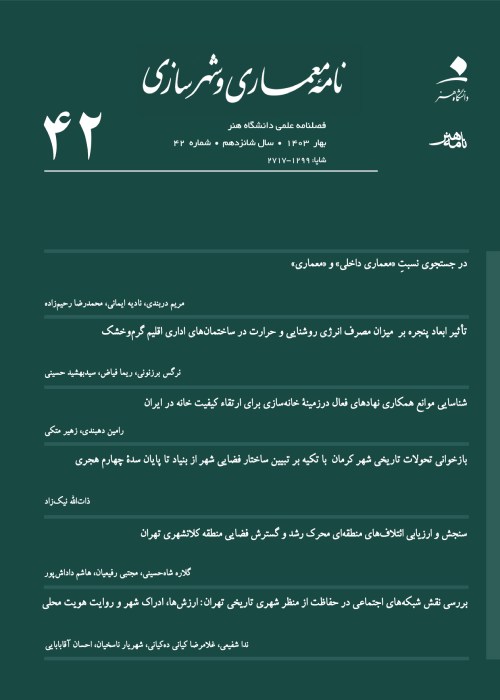Parametric Design of a Kinetic Facade for the Improvement of Daylight Performance and Visual Comfort Case Study: An Office Space in Tehran
Author(s):
Article Type:
Research/Original Article (دارای رتبه معتبر)
Abstract:
Daylighting has significant impacts on the physiological and psychological needs of people in addition to reducing energy consumption. Furthermore, it should be noted that excessive daylight can cause visual discomfort and glare. Therefore, the reasons for the growing attention towards the responsive kinetic skins are increasing the indoor lighting levels while controlling glare and providing visual comfort due to different weather conditions during the year. This research proposes and evaluates a sun-responsive kinetic skin consisting of an Islamic pattern for the improvement of indoor environmental conditions. The use of Islamic patterns has a long history and a special significance in Iranian-Islamic architecture, and its geometric and iterative design is correspondent with the idea of the kinetic skin. With the aim of increasing the illuminance level while reducing the risk of glare, the minimum and maximum solar altitude angles are considered corresponding to the skin opening ratio (50-100%), so that the lowest solar altitude angle is corresponding to the highest opening ratio, and the highest solar altitude angle is corresponding to the lowest opening ratio. The case study is a 7-meter deep south-oriented office space in Tehran. The depth of 7-meter is commonly used for conceptual design explorations and it is also chosen to be this large so that the effect of daylighting remains visible for all adaptive façade variations. Furthermore, horizontal louvers are deployed among the facade to control excessive unwanted daylight. The aim of this study is to provide a visual comfort level based on the LEED certificate. According to LEED, spatial daylight autonomy (SDA) of at least 50%, and annual sunlight exposure (ASE) of no more than 10% is recommended. The proposed envelope was evaluated using Grasshopper/Rhino for parametric simulation, Ladybug for inputting time zones and delivering sun position coordinates, Honeybee for analyzing daylight and glare, and online software ‘Design Explorer’ for extracting optimum solutions. The reflectance of the floor, ceiling, and walls are considered 20%, 80% and 50%, respectively, according to the conventional materials. Louver depth (50 and 100 centimeters), louver material (plastic and aluminium), glass material (double glazed low emissivity glass, and double-glazed clear glass), and the kinetic skin material (plastic and aluminium) were considered as input variables. Test points were chosen 0.5 meters apart and 0.8 meters high from the floor (desk height). The glare analyses were conducted during the winter solstice (December 21st), spring equinox (March 21st), autumn equinox (September 23st), and the summer solstice (June 21st) at 09:00h, 12:00h, and 16:00h, in order to meet extreme sun angles. In this study, 360 glare analyses and 30 annual daylight analyses were performed. The results show that the proposed system is efficiently capable of achieving imperceptible glare most of the time and providing the improvement of daylight performance and visual comfort level based on the LEED certificate. Useful daylight illuminance (UDI) increases by around 20 percent. Despite the decrease in spatial daylight autonomy (SDA) by around 3-20 percent, annual solar exposure (ASE) decreases by around 40-50 percent.
Keywords:
Language:
Persian
Published:
Journal of Architecture and Urban Planning, Volume:13 Issue: 31, 2021
Pages:
85 to 100
magiran.com/p2337897
دانلود و مطالعه متن این مقاله با یکی از روشهای زیر امکان پذیر است:
اشتراک شخصی
با عضویت و پرداخت آنلاین حق اشتراک یکساله به مبلغ 1,390,000ريال میتوانید 70 عنوان مطلب دانلود کنید!
اشتراک سازمانی
به کتابخانه دانشگاه یا محل کار خود پیشنهاد کنید تا اشتراک سازمانی این پایگاه را برای دسترسی نامحدود همه کاربران به متن مطالب تهیه نمایند!
توجه!
- حق عضویت دریافتی صرف حمایت از نشریات عضو و نگهداری، تکمیل و توسعه مگیران میشود.
- پرداخت حق اشتراک و دانلود مقالات اجازه بازنشر آن در سایر رسانههای چاپی و دیجیتال را به کاربر نمیدهد.
In order to view content subscription is required
Personal subscription
Subscribe magiran.com for 70 € euros via PayPal and download 70 articles during a year.
Organization subscription
Please contact us to subscribe your university or library for unlimited access!




